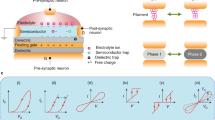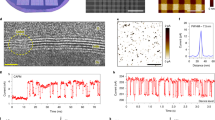Abstract
A single biological neuron can efficiently perform Boolean operations. Artificial neuromorphic systems, on the other hand, typically require several devices to complete a single operation. Here, we show that neuristors that exploit the intrinsic polarity of two-dimensional materials can perform logic operations in a single device. XNOR gates can be made using ambipolar tungsten diselenide (WSe2), NOR gates using p-type black phosphorus, and OR and AND gates using n-type molybdenum disulfide (MoS2) of different thicknesses. To illustrate the potential of the neuristors, we fabricate logic half-adder and parity-checker circuits using a WSe2 neuristor and a MoS2 neuristor in a two-transistor two-resistor configuration, offering an area saving of 78% compared to circuits based on MoS2 gates in a traditional design. We also propose a binary neural network that is based on a three-dimensional XNOR array, which simulations show should offer an energy efficiency of 622.35 tera-operations per second per watt and a power consumption of 7.31 mW.
This is a preview of subscription content, access via your institution
Access options
Access Nature and 54 other Nature Portfolio journals
Get Nature+, our best-value online-access subscription
$29.99 / 30 days
cancel any time
Subscribe to this journal
Receive 12 digital issues and online access to articles
$119.00 per year
only $9.92 per issue
Buy this article
- Purchase on Springer Link
- Instant access to full article PDF
Prices may be subject to local taxes which are calculated during checkout




Similar content being viewed by others
Data availability
The data that support the plots within this paper and other findings of this study are available from the corresponding author upon reasonable request. Source data are provided with this paper.
References
Das, S., Dodda, A. & Das, S. A biomimetic 2D transistor for audiomorphic computing. Nat. Commun. 10, 3450 (2019).
Jayachandran, D. et al. A low-power biomimetic collision detector based on an in-memory molybdenum disulfide photodetector. Nat. Electron. 3, 646–655 (2020).
Li, X. et al. Power-efficient neural network with artificial dendrites. Nat. Nanotechnol. 15, 776–782 (2020).
Gidon, A. et al. Dendritic action potentials and computation in human layer 2/3 cortical neurons. Science 367, 83–87 (2020).
Choi, S. et al. SiGe epitaxial memory for neuromorphic computing with reproducible high performance based on engineered dislocations. Nat. Mater. 17, 335–340 (2018).
Xia, Q. & Yang, J. J. Memristive crossbar arrays for brain-inspired computing. Nat. Mater. 18, 309–323 (2019).
Sebastian, A., Le Gallo, M., Khaddam-Aljameh, R. & Eleftheriou, E. Memory devices and applications for in-memory computing. Nat. Nanotechnol. 15, 529–544 (2020).
Fuller, E. J. et al. Parallel programming of an ionic floating-gate memory array for scalable neuromorphic computing. Science 364, 570–574 (2019).
Huang, P. et al. Reconfigurable nonvolatile logic operations in resistance switching crossbar array for large‐scale circuits. Adv. Mater. 28, 9758–9764 (2016).
Kumar, S., Williams, R. S. & Wang, Z. Third-order nanocircuit elements for neuromorphic engineering. Nature 585, 518–523 (2020).
Zhu, X., Li, D., Liang, X. & Lu, W. D. Ionic modulation and ionic coupling effects in MoS2 devices for neuromorphic computing. Nat. Mater. 18, 141–148 (2019).
Liu, C. et al. Two-dimensional materials for next-generation computing technologies. Nat. Nanotechnol. 15, 545–557 (2020).
Marega, G. M. et al. Logic-in-memory based on an atomically thin semiconductor. Nature 587, 72–77 (2020).
Shi, Y. et al. Electronic synapses made of layered two-dimensional materials. Nat. Electron. 1, 458–465 (2018).
Chen, H. et al. Time‐tailoring van der Waals heterostructures for human memory system programming. Adv. Sci. 6, 1901072 (2019).
Wachter, S., Polyushkin, D. K., Bethge, O. & Mueller, T. A microprocessor based on a two-dimensional semiconductor. Nat. Commun. 8, 14948 (2017).
Liu, Y., Huang, Y. & Duan, X. Van der Waals integration before and beyond two-dimensional materials. Nature 567, 323–333 (2019).
Mennel, L. et al. Ultrafast machine vision with 2D material neural network image sensors. Nature 579, 62–66 (2020).
Yu, L. et al. Design, modeling and fabrication of chemical vapor deposition grown MoS2 circuits with E-mode FETs for large-area electronics. Nano Lett. 16, 6349–6356 (2016).
Dathbun, A. et al. Large-area CVD-grown sub-2-V ReS2 transistors and logic gates. Nano Lett. 17, 2999–3005 (2017).
Lin, Z. et al. Solution-processable 2D semiconductors for high-performance large-area electronics. Nature 562, 254–258 (2018).
Resta, G. V. et al. Doping-free complementary logic gates enabled by two-dimensional polarity-controllable transistors. ACS Nano 12, 7039–7047 (2018).
Wu, P., Reis, D., Hu, X. S. & Appenzeller, J. Two-dimensional transistors with reconfigurable polarities for secure circuits. Nat. Electron. 4, 45–53 (2021).
Lee, S.-J. et al. Programmable devices based on reversible solid-state doping of two-dimensional semiconductors with superionic silver iodide. Nat. Electron. 3, 630–637 (2020).
Liu, C. et al. Small footprint transistor architecture for photoswitching logic and in situ memory. Nat. Nanotechnol. 14, 662–667 (2019).
Pan, C. et al. Reconfigurable logic and neuromorphic circuits based on electrically tunable two-dimensional homojunctions. Nat. Electron. 3, 383–390 (2020).
Cheng, R. et al. High-performance, multifunctional devices based on asymmetric van der Waals heterostructures. Nat. Electron. 1, 356–361 (2018).
Si, M. et al. Steep-slope WSe2 negative capacitance field-effect transistor. Nano Lett. 18, 3682–3687 (2018).
Movva, H. C. et al. High-mobility holes in dual-gated WSe2 field-effect transistors. ACS Nano 9, 10402–10410 (2015).
Li, L. et al. Black phosphorus field-effect transistors. Nat. Nanotechnol. 9, 372–377 (2014).
Lee, Y. T. et al. Nonvolatile charge injection memory based on black phosphorous 2D nanosheets for charge trapping and active channel layers. Adv. Funct. Mater. 26, 5701–5707 (2016).
Radisavljevic, B., Radenovic, A., Brivio, J., Giacometti, V. & Kis, A. Single-layer MoS2 transistors. Nat. Nanotechnol. 6, 147–150 (2011).
Si, M. et al. Steep-slope hysteresis-free negative capacitance MoS2 transistors. Nat. Nanotechnol. 13, 24–28 (2018).
Pang, C. S. et al. First demonstration of WSe2 CMOS inverter with modulable noise margin by electrostatic doping. In Proc. 2018 76th Device Research Conference (DRC) 1–2 (IEEE, 2018).
Liu, Yuan et al. Approaching the Schottky–Mott limit in van der Waals metal–semiconductor junctions. Nature 557, 696–700 (2018).
Nourbakhsh, A. et al. MoS2 field-effect transistor with sub-10-nm channel length. Nano Lett. 16, 7798–7806 (2016).
Cheng, C. C. et al. First demonstration of 40-nm channel length top-gate WS2 pFET using channel area-selective CVD growth directly on SiOx/Si substrate. In Proc. 2019 Symposium on VLSI Technology T244–T245 (IEEE, 2019).
Paletti, P. et al. Electric double layer Esaki tunnel junction in a 40-nm-length, WSe2 channel grown by molecular beam epitaxy on Al203. In Proc. 2018 48th European Solid-State Device Research Conference (ESSDERC) 110–113 (IEEE, 2018).
Xiang, L. et al. Low-power carbon nanotube-based integrated circuits that can be transferred to biological surfaces. Nat. Electron. 1, 237–245 (2018).
Zhang, H. et al. High-performance carbon nanotube complementary electronics and integrated sensor systems on ultrathin plastic foil. ACS Nano 12, 2773–2779 (2018).
Yang, H. et al. Graphene barristor, a triode device with a gate-controlled Schottky barrier. Science 336, 1140–1143 (2012).
Yao, P. et al. Fully hardware-implemented memristor convolutional neural network. Nature 577, 641–646 (2020).
Lin, X., Zhao, C. & Pan, W. Towards accurate binary convolutional neural network. In Advances in Neural Information Processing Systems 345–353 (NIPS, 2017).
Acknowledgements
This work was supported by the National Natural Science Foundation of China (61925402, 61851402 and 62090032), Science and Technology Commission of Shanghai Municipality (19JC1416600), Shanghai Education Development Foundation and Shanghai Municipal Education Commission Shuguang Program (18SG01), Key Research Program of the Chinese Academy of Sciences (grant no. XDPB22) and the Strategic Priority Research Program of the Chinese Academy of Sciences (XDB44000000).
Author information
Authors and Affiliations
Contributions
P.Z. and W.H. conceived the idea and supervised the experiments. H.C. performed device fabrication and electrical characteristics measurements. J.W., Z.W. and W.H. provided valuable input to the experiments. X.X. and J.F. designed the hardware for the BCNN and performed the simulation. H.C., C.L., W.H. and P.Z. wrote the manuscript, with help from all authors.
Corresponding authors
Ethics declarations
Competing interests
The authors declare no competing interests.
Additional information
Peer review information Nature Electronics thanks Shi-Jun Liang and the other, anonymous, reviewer(s) for their contribution to the peer review of this work.
Publisher’s note Springer Nature remains neutral with regard to jurisdictional claims in published maps and institutional affiliations.
Supplementary information
Supplementary Information
Supplementary sections 1–12 and Figs. 1–31.
Supplementary Data 1
Statistical supplementary data.
Source data
Source Data Fig. 1
Statistical source data.
Source Data Fig. 2
Statistical source data.
Source Data Fig. 3
Statistical source data.
Rights and permissions
About this article
Cite this article
Chen, H., Xue, X., Liu, C. et al. Logic gates based on neuristors made from two-dimensional materials. Nat Electron 4, 399–404 (2021). https://doi.org/10.1038/s41928-021-00591-z
Received:
Accepted:
Published:
Issue Date:
DOI: https://doi.org/10.1038/s41928-021-00591-z
This article is cited by
-
On-chip optoelectronic logic gates operating in the telecom band
Nature Photonics (2024)
-
Reconfigurable, non-volatile neuromorphic photovoltaics
Nature Nanotechnology (2023)
-
Full hardware implementation of neuromorphic visual system based on multimodal optoelectronic resistive memory arrays for versatile image processing
Nature Communications (2023)
-
Computational event-driven vision sensors for in-sensor spiking neural networks
Nature Electronics (2023)
-
Graphene/MoS2−xOx/graphene photomemristor with tunable non-volatile responsivities for neuromorphic vision processing
Light: Science & Applications (2023)



